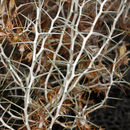en
names in breadcrumbs


Fire adaptations: Horsebrushes are "slightly damaged by fire" [45]: top-growth is removed. Spiny horsebrush sprouts from the root crown and rhizomes after fire [9,41,56,61]. It also establishes from seed after fire [62].
FIRE REGIMES: Fires in the desert shrub ecosystems in which spiny horsebrush occurs were historically infrequent and stand replacing. Spiny horsebrush is most common on dry sites with sparse vegetation cover [7,10], and fires are rare on spiny horsebrush-dominated sites due to sparse fuels [41,42]. Fires in the pinyon-juniper types with a spiny horsebrush component were of mixed severity [42].
The following table provides fire return interval for plant communities and ecosystems with spiny horsebrush. Find further fire regime information for the plant communities in which this species may occur by entering the species name in the FEIS home page under "Find FIRE REGIMES".
Community or Ecosystem Dominant Species Fire Return Interval Range (years) sagebrush steppe Artemisia tridentata/Pseudoroegneria spicata 20-70 [42] basin big sagebrush Artemisia tridentata var. tridentata 12-43 [48] mountain big sagebrush Artemisia tridentata var. vaseyana 15-40 [1,11,36] Wyoming big sagebrush Artemisia tridentata var. wyomingensis 10-70 (40**) [57,63] saltbush-greasewood Atriplex confertifolia-Sarcobatus vermiculatus western juniper Juniperus occidentalis 20-70 Rocky Mountain juniper Juniperus scopulorum pinyon-juniper Pinus-Juniperus spp. 42] **meanSpiny horsebrush occurs on dry, open foothills, plains, and alkali sinks [16,34]. It grows on skeletal to deep soils [5,24] with clay and loam textures [5,59]. Sites with a large spiny horsebrush component are often mostly bare ground. In west-central Colorado, a spiny horsebrush community showed 15% plant cover (9% of which was spiny horsebrush), 8% litter cover, and 77% bare soil. Although the soil was moist, it was the saltiest of 13 plant communities studied. Researchers speculated that most soil water was lost to evaporation [7]. A northeastern Utah study found spiny horsebrush dominance was correlated with bare ground and soils with poor cation exchange and high concentrations of soluble salts [10].
Spiny horsebrush generally occurs from 2,600 to 6,600 feet (800-2,000 m) elevation, although it is rarely found as high as 8,900 feet (2,700 m) [16]. Elevational ranges by state are:
CA 2,600-7,900 feet (800-2,400 m) [24,27] CO 4,500-7,000 feet (1,400-2,100) [26] UT 1,400-6,300 feet (1,250-1,925 m) [60]Climate on spiny horsebrush sites is often harsh, with hot summers and cool to cold winters. A Nevada ephedra-spiny horsebrush site in the Owens Valley of California showed a mean weekly maximum summer temperature of 104 oFahrenheit (40 oC), 0.9 inch (240 mm) total summer precipitation, and mean total windspeed of 62.1 miles/day (99.9 km/day) [13].
Palatability: Spiny horsebrush is not a toxic horsebrush species [19,49,52,54], but browsers seldom use it. Horsebrushes are unpalatable except early in the spring, when animals may consume young shoots and buds [29,49]. Domestic sheep on saltdesert shrublands in Utah browsed spiny horsebrush only incidentally. Use was 0.9% in the 1st year of the study and 0% in the 2nd [22]. Palatability of spiny horsebrush has been rated as follows [17]:
Nutritional value: Mean nutritional content of spiny horsebrush browse is as follows [39]:
Nutrient % ash 5.4 crude fiber 36.8 ether extract 6.3 N-free extract 42.8 Protein (N Ã 6.25) 8.7 cattle (digestible protein) 5.3 domestic goats (digestible protein) 4.7 horses (digestible protein) 4.9 domestic rabbits (digestible protein) 5.4 domestic sheep (digestible protein) 5.1 calcium 0.94 phosphorus 0.25Cover value: Spiny horsebrush provides cover for small animals [34].
Spiny horsebrush regenerates from seed and by sprouting from rhizomes and the root crown [9,41,56,61,62]. Information on seed production, viability, and dispersal, seed banking, and seedling establishment is scant for spiny and other horsebrushes. Further research is needed on the reproductive ecology of this genus.
Breeding system: Spiny horsebrush may often be self-fertilized by individuals within a colony connected by rhizomes [53].
Pollination: Horsebrushes are pollinated by insect generalists including flies, moths, bees, and beetles [35].
Seed dispersal: Horsebrush seeds are wind dispersed [64]. The hairs on horsebrush pappi aid dispersal [20].
Seedling establishment/growth: Seedling establishment is rare in horsebrushes, probably due to harsh environments [53]. Spiny horsebrush seedlings were observed on a prescribed burned site in southeastern Oregon [62].
Asexual regeneration: Spiny horsebrush forms small colonies from rhizomes, which may extend 1 foot (30 cm) from the parent plant [37,53]. It also sprouts from the root crown [41,61].
The scientific name of spiny horsebrush is Tetradymia spinosa Hook.
& Arn. (Asteraceae) [16,27,30,53,59,60]. Cronquist and others [16] recognize 2 varieties characterized by
relatively short, recurved spines and
relatively long, straight spines, respectively:
Tetradymia spinosa var. spinosa
Tetradymia spinosa var. longispina M. E. Jones